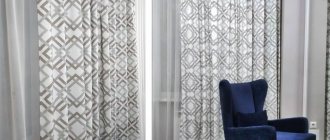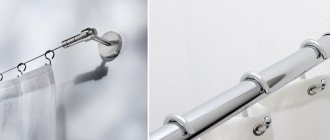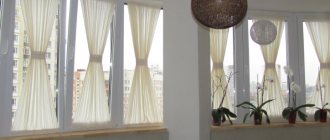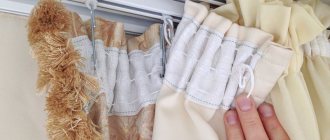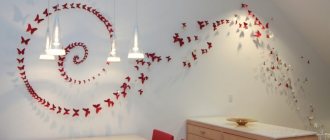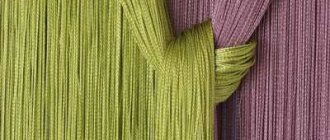Hooks for curtain tape – the main component for any curtain rod.
What are they, how many of them do you need and how to use them? This is one of the first questions for new users of newly installed curtain rods. Modern manufacturers of curtain rods work tirelessly to improve the quality of not only curtain rods, but also hooks for curtain tape , so using them today is a pleasure. You just need to know some little things.
How to hang curtains on a curtain rod with rings?
In this case, the mounting diagram is as follows:
- curtain rod rings are put on the curtain rod pipe (the rings are used to move the curtain along the curtain rod pipe)
- hangers - hooks - are attached to the rings
- curtains are hung on hooks.
Interesting materials:
Where is our waist? Where is the top and bottom of a roll of wallpaper? Where do you study to become an interior designer? Where do they study to become an ambassador? Where to study in Finland? Where to study abroad after school for free? Where to study abroad? Where to study abroad? Where to indicate the taxation system when registering an individual entrepreneur? Where to install the TV?
How to hang curtains so that they hang in even folds without resorting to tying them with tape?
Let me make a reservation right away: this method is suitable if you first put hooks on the curtains, and only then hang them on the curtain rod. Ceiling cornices are ideal in this case.
I advise you to take a closer look at the ceiling rail cornices. They are simple in design and not at all “capricious” to use. They are not afraid of high humidity, high/low temperatures, or direct sunlight. The lightweight “tire” has amazing strength and is suitable even for heavy curtains. “Plus” it is affordable and widespread - for example, you can choose ceiling cornices in the form of tires in this store.
Well, in our case, it is especially important that the tire curtain rod uses runner hooks that slide along the track inside the profile. Such runners are ideal for the method of creating uniform folds on the curtain, which I will discuss later.
We calculate the amount of material for this method of hanging curtains. We take the coefficient 1.5 plus 10 cm for the technical folds of the curtains (we want them to hang beautifully) plus 4 cm for hems of the side sections.
Let's say the width of the cornice is 3m. We need to sew 2 curtains. 3x1.5=4.5m. We turn each curtain on the sides (technical folds) by 10 cm, this is another 0.4 m. And four side seams - plus 16cm. In total we get 4.5 + 0.4 + 0.16 = 5.06 m. You can round it up to five meters exactly.
Why are technical tricks needed? You can, of course, do without them, but I personally prefer it when the side seams are not visible, especially since sometimes the side seam cannot be ironed properly (such fabrics do occur).
Curtain fabrics - a large selection, convenient service for selecting fabrics and calculating the cost of curtains on the website of our partner, the DrapeShop online store.
Let's move on to practice. We retreat 10cm from the side edge of the curtain and hang a hook - this will be the outermost hook.
We fold the curtain along this hook, and hang the next hook on two loops at once - the outermost one and the one opposite it. With this action we get a technical twist. By the way, it can be made simpler - just tuck it in when you sew on the braid.
We put the next hook on the loop (closer to the collar) and use it to thread the second loop through five centimeters. It turned out to be a small fold.
Next, we place hooks along the entire width of the curtain in the same way, the distance between the hooks is 10cm, and between the loops on one hook - 5cm.
Don't forget about the technical fold on the other side of the curtain.
The result was these uniform shallow folds across the entire width of the curtain. This is exactly how the curtain will hang when the window is curtained.
When the curtains are pulled apart, they will also hang in even folds, only the folds will be deeper.
In this way, you can hang not only curtains, but also tulle, if its gathering factor is not large. It is quite difficult to evenly distribute the gathering on the braid with a small coefficient; it turns out “where it is thick and where it is empty,” and in this case we will get a uniform gathering.
If something is not clear, ask in the comments, I will answer all your questions.
Did you like the master class? I would be very grateful if you share this article with your friends on social networks by clicking on any button below.
If you would like to share your experience with the readers of the site or simply show your work, write and send a photo to me by email.
Best regards, Oksana Fadeeva.
Use of site materials only if there is an active link
Types of fasteners for curtains
You can hang curtains using the following parts:
Attaching curtains to rings with hooks
This is the most popular method. They can be used in pairs or the curtains can be hung only on hooks. In any case, before this you will need to sew loops on the curtains, or select products with curtain tape. Rings and hooks are suitable for light and airy curtains.
How to hang curtains on hooks photo
"Crocodiles"
They are metal clothespins with teeth at the ends. This solution allows you to securely fasten the curtain in the desired position. If the curtain is light, then you can use clips. In principle, they are similar to “crocodiles”, only they are made of plastic and are not equipped with teeth.
Attaching curtains to eyelets
These are metal rings that are inserted directly into the fabric. Therefore, you first need to prepare the holes and, if necessary, hem them. Eyelets are used only for tubular cornices. With their help you can achieve beautiful folds.
Attaching curtains to eyelets
Fastening with fabric loops
To make them, the same material is taken from which the curtains are made. Such fastenings are more suitable for decorative curtains, country-style rooms, and kitchens. Fabric loops can be decorated in the form of a bow or ribbon. This option will add zest to the room.
Kulisok
The fastening not only helps to hold the curtains and form beautiful folds, but also to close the curtain rod. For this purpose, a special pocket is made when sewing curtains. The cornice pipe is passed through it. As a result, it is completely hidden behind the fabric. It seems that the curtains are attached to the ceiling.
Particular attention should be paid to modern curtains. For example, lifting curtains (French, Roman) are not attached using standard loops or clips. They are mounted on a lifting cornice. The types of fasteners should come with it in the kit. If they are not there, then look for a hint in the instructions. The curtains are lifted using a cord. To hang roller curtains, often used in the kitchen, in addition to the clamps, two fishing lines are prepared.
At what distance should curtain holders be attached?
The tie line is located at a height of 1/3 or 2/3 of the drapery, but not lower than 100 cm from the floor. This distance allows the use of brushes. In this case, the visible attachment point of the grabber (usually a brass or wooden holder) is located at ½ the height of the drapery.
Interesting materials:
How to cut 10 cm foam? What should you consider when compiling a list of cases? How to make paths in the country? How to putty the façade before painting? How to glue a silumin part? How to glue polyethylene parts? What is the yellow watermelon crossed with? How to grease the surface of the pie? What to use instead of yolk? How to lubricate a drill when drilling metal?
Curtain hooks - their features
There are many ways to hang curtains on a curtain rod, but curtain hooks are the most common of them. We are talking about those elements that are attached to rings, and about independent fastenings. Most often they are used on profile cornices mounted on a wall or ceiling, but if necessary, a suitable option can also be selected for round or string models.
The hook fastening can be used without a cornice; for this you will need to fix special wall hooks at a certain distance from each other; for example, below are several photographs of this method of hanging. This option is an ideal solution when you plan to hang a light curtain that will not be moved during use.
Plastic and metal-plastic hooks are capable of holding light to medium-weight fabric. When decorating window openings with heavy curtain fabrics, it is better to use metal hooks, installing grommets on the curtains or sewing patches on them.
The main advantage of such fasteners is that the canvases hung on hooks can easily and freely move along the entire length of the cornice in both directions. If necessary (for example, if the curtains need to be washed), they can be easily removed, and if the hook breaks, it can be easily replaced with a new one.
Selecting curtain sizes
Now you need to determine how to choose the right size of curtains and tulle. That is, find out what the dimensions of the curtains should be for a certain width of translucent curtains. The curtain curtain has a denser structure. Therefore, the KS will be less than for light veils and will be k = 1.5-2.
The higher the gathering factor, the more magnificent the folds on the curtains will be.
Let's calculate the required amount of material for thick curtains, which do not drape well due to their rough texture.
The length of the cornice is 3 m.
KS = 1.5.
Allowances – 6 cm.
Amount of curtain material: 300 cm x 1.5 = 450 cm + 6 cm (allowances) = 456 cm or 4 meters 56 cm.
As a result, you will get drapery as in the photo
If the texture is a little softer, lighter, and allows you to create a beautiful drapery, then the KS can be chosen more - k=2. Then the calculation will look like this:
The length of the cornice is 3 m.
KS = 2.
Allowances – 6 cm.
Amount of curtain material: 300 cm x 2 = 600 cm + 6 cm (allowances) = 606 cm or 6 meters 6 cm.
The photo shows curtains with a drapery ratio of 1:2
Build factor
The gathering factor (GC) is a value that helps determine how much fabric needs to be gathered across the width. Essentially, this is the allowance for the waves and tails, and it determines how magnificent they will be in the end.
The gathering factor depends on the type of folds formed on the curtain fabric
Before you calculate the width of the tulle for the window, you need to find out what the KS will be. To do this you need to know two quantities:
- Length of cornice.
- Braid model.
The width of the footage is calculated using a simple formula:
Amount of fabric = k x curtain rod length
Where k is the assembly (filling) coefficient. For different types of assembly that the braid forms, it will be different:
- Pencil – k = 2.5-3.
- Buffs – k = 1.5 – 2.5.
- “Crow's feet” – k = 2.
- Goblet-shaped, bow-shaped – k = 2.5-3.
Note! The KS must be indicated on the packaging of the curtain tape. Typically the average ratio is 1:2.5. It is suitable for almost any curtain design.
Knowing the CS, all that remains is to calculate the required amount of tissue. If, for example, k = 1.5, and the length of the cornice is 275 cm, then to sew curtains you will need to collect 375 cm (3.75 meters) of fabric (1.5 x 250 cm = 375 cm).
Important. When calculating, it is necessary to add allowances for the side seams. As a rule, add 6 cm, 3 cm for each side seam.
Processing the side cut of the curtain
In our example, to the width of 3.75 m, you also need to add 6 cm for the side seams. The total width of the fabric will be 3 m 81 cm.
